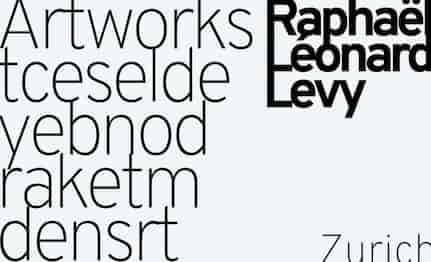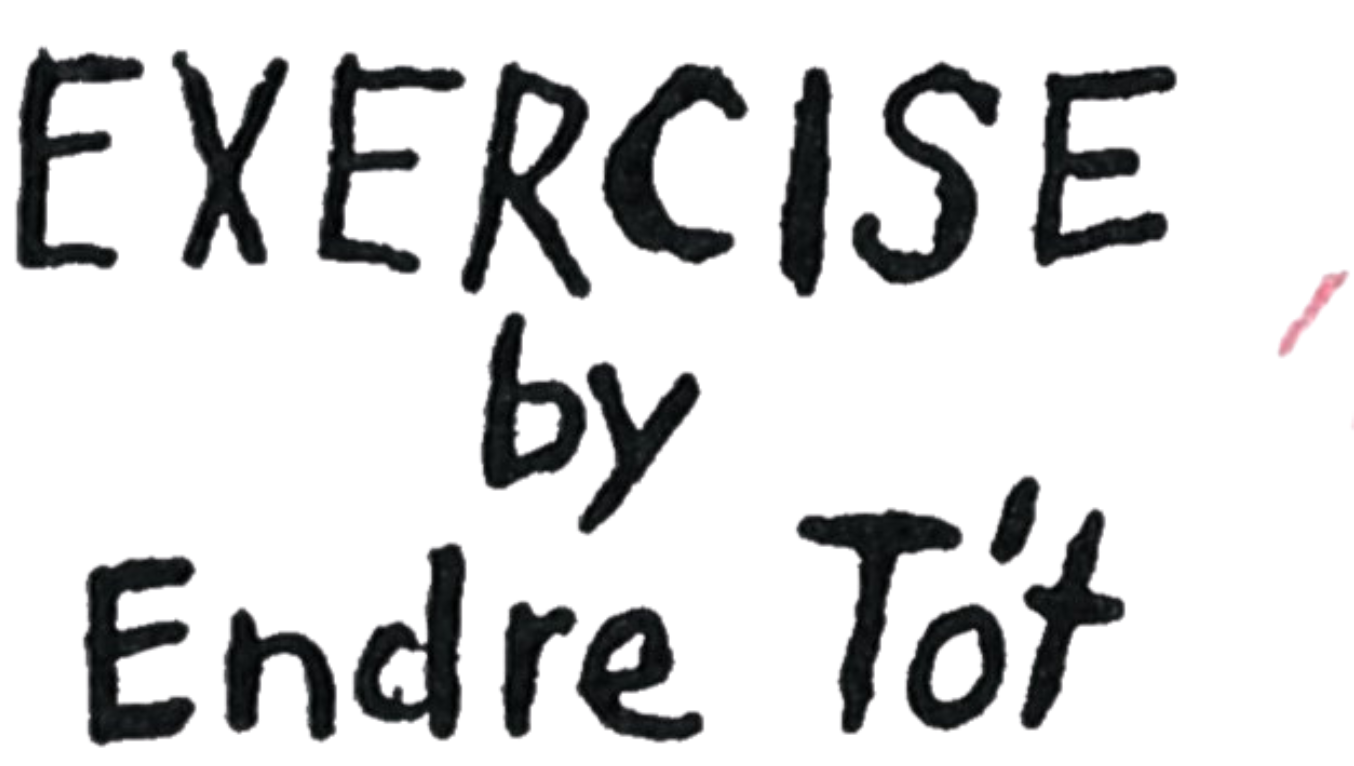
EXERCISE by Endre Tót
ED. NR. 6 — Oldenburg (West Germany): International Artist’s Cooperation (I.A.C), Klaus Groh, publisher, 1973.
16 numbered pages, softcover, staple binding (1 staple), 105 x 75 mm; black and white Xerox printing.
Edition of 80 numbered copies.
In our copy: artist’s signature in pencil on the cover; original red ink stamp imprint reading: "Hey/ Look/ Here are beautiful new zerOOOOOOOOOOO from Hungary—Endre Tot 1974."
Original re-edition from 2004 also exists (80 numbered copies), with colored covers and blue stamps ("E T" + "ED: NR.6").

EXERCISE by Endre Tót
ED. NR. 6
Oldenburg (West Germany): International Artist’s Cooperation (I.A.C), Klaus Groh, publisher, 1973.
16 numbered pages, softcover, staple binding (1 staple), 105 x 75 mm; black and white Xerox printing.
Edition of 80 numbered copies.
In our copy: on the cover, the artist's signature in pencil; an original red ink stamp imprint reading:
"Hey/ Look/ Here are beautiful new zerOOOOOOOOOOO from Hungary—Endre Tot 1974."
On the title, to the right, there is a red ink stain.
There exists an original re-edition from 2004*, consisting of 80 numbered copies, dated in pencil. The stapled sheets (1 staple) have a colored cover (we have a light blue and a cyan blue copy). The monogram “E T” is stamped on the cover in blue ink, and the number 6 (ED: NR.6) is stamped on the back cover in blue ink.
Our two copies are numbered on the inside back cover:
*Klaus Groh provided information regarding the difference between the two editions in a message exchange with R. Levy:
"(...) The 2004 version is an original reprint. The only difference lies in the quality of the paper."
On the next page I shall say something
Budapest: self-published (samizdat), 1973.
8 pages (including cover), staple binding, 208 x 149 mm; black and white offset printing.
Edition of 100 numbered copies.
Back cover of our copy: numbered "2" in blue ballpoint pen, with a typewritten inscription:
"copyright Endre Tót Budapest spring’73".

On the next page I shall say something
Budapest: self-published (samizdat), 1973.
8 pages (including cover), staple binding, 208 x 149 mm; black and white offset printing.
Edition of 100 numbered copies.
The back cover of our copy is numbered "2" in blue ballpoint pen, with a typewritten inscription:
"copyright Endre Tót Budapest spring’73".
DZIESIEĆ PYTAŃ
Łódź (Poland): Galerie Adres, Ewa Partum, publisher, self-published, May 1973.
In-folio, 4 pages, cardboard paper, 302 x 207 mm, two-color screen printing (black and white).
Signed and dated in pencil (front); signature in blue ballpoint pen (back). Approx. 100–150 copies, according to Ewa Partum.
Brochure for Tót’s exhibition at Galerie Adres. Back cover includes biography, exhibition list, and bibliography.
Text in Polish with 10 questions covered in "0", only "Dlaczego" ("Why") and "Dlaczego pytam?" remain legible.

DZIESIEĆ PYTAŃ
Łódź (Poland): Galerie Adres, Ewa Partum, publisher, self-published, May 1973.
In-folio, 4 pages, cardboard paper, 302 x 207 mm, two-color screen printing (black and white).
Our copy is signed and dated in pencil at the bottom right of the front cover. On the back cover, the signature appears in blue ballpoint pen at the bottom center.
There is no indication of the number of copies printed; however, according to Ewa Partum, between 100 and 150 copies were produced.
Brochure for Endre Tót’s exhibition at Galerie Adres.
The back cover includes the artist’s biography, a list of his exhibitions, and bibliographic references.
The text is screen-printed in white on a full black background. It consists of 10 questions (in Polish) covered with "0", with only the word "Dlaczego" (Why) remaining legible, along with the final question: "Dlaczego pytam?" (Why do I question?).
I am glad if I can write sentences, one after the other
Budapest: self-published (samizdat), 1973.
8 pages including cover, staple binding, 195 x 143 mm; black and white offset printing.
Edition of 100 numbered copies. Our copy is numbered 44 in blue marker, with inscription: "copyright Endre Tót Budapest autumn’73".
Audio version: cassette recorded during the exhibition at Galerie St. Petri, Lund (Jean Sellem), 17 November 1979.
Tót repeats: “I am glad if I can say sentences, one after the other” in a continuous loop.

I am glad if I can write sentences, one after the other
Budapest: self-published (samizdat), 1973.
8 pages (including cover), staple binding, 195 x 143 mm; black and white offset printing.
Edition of 100 numbered copies.
Our copy is numbered 44 in blue marker on the back cover, with a typewritten inscription:
"copyright Endre Tót Budapest autumn’73".
There is an audio version of this work. A cassette recording was made during Endre Tót’s exhibition at Galerie St. Petri (Jean Sellem) in Lund, Sweden, on November 17, 1979.
Endre Tót recites the phrase "I am glad if I can say sentences, one after the other" in a continuous loop.
Click on the image above
ONE DOZEN RAIN POSTCARDS
Budapest, self-published (samizdat), 1973.
12 postcards, 93 x 142 mm, in a light blue three-flap folding sleeve (93 x 147 mm); black and white offset printing.
No edition size indicated; according to Endre Tót (visit on Sept. 25, 2023), fewer than 50 copies exist.
Our copy is signed and dated in black ballpoint pen on the back of the central flap.
The title and author’s name are printed on the left flap. The outer central panel lists all 12 postcard titles. The right flap contains the dedication: “to H.P.” (*Herta Paraschin).

ONE DOZEN RAIN POSTCARDS
Budapest, self-published (samizdat), 1973.
12 postcards, 93 x 142 mm, in a light blue three-flap folding sleeve (93 x 147 mm); black and white offset printing.
There is no indication of the number of copies produced. According to Endre Tót (visit on September 25, 2023), fewer than 50 copies exist.
Our copy is signed and dated in black ballpoint pen by the artist on the back of the central flap of the sleeve.
On the left flap of the cover, the title and the author’s name are printed. On the outer central panel, the title appears along with a numbered list of the postcards and their respective titles. On the right flap, there is a dedication: "to H.P."
* This refers to Herta Paraschin.